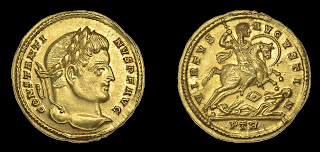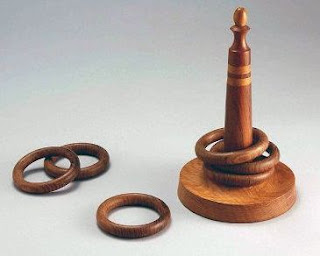In "The Shipman's Tale" of Chaucer's
Canterbury Tales, a monk gains the trust of a friend's wife by invoking St. Martin of Tours, a testament to the power of even the name of this enormously popular saint.
Martin was born in Pannonia (Hungary) in Gaul to pagan parents, he was raised in Italy and forced into military service at the age of 15. He started learning about Christianity and was baptized at 18. (Note: there are very conflicting reports about his birth year, with 316 and 336 offered up, neither of which can be verified. His death on 8 November 397 is certain, but whether he was 60 or 81 we cannot know. The 336 year is preferred by modern scholars.)
His position was with the cavalry, likely the heavily armed Equites cataphractarii. Once he became a Christian, however, he refused to fight. His biographer, Sulpicius Severus, writes that he was jailed for this refusal, and that he offered to go unarmed to the front of the line in an imminent battle in Gaul. This was deemed acceptable, but the opponents made peace with Rome, the battle never happened, and Martin was released from service.
Martin vowed to be a monk, and went to Caesarodunum (Tours) to become a follower of Bishop Hilary of Poitiers (see here) and join his quest against the Arians. In the ensuing years, he fought against Arians, sometimes losing; converted many, including his mother (but not his father); rejoined Hilary in 361, where he established a hermitage nearby. This developed into the oldest monastery in Europe, Ligugé Abbey. As of this writing, the abbey has 25 monks.
In 371, Martin was asked to come to Tours to aid a sick person; he was enticed into the church, where he was convinced to be named the third bishop of Tours. His demeanor very public life of a bishop disd not suit him, especially the negative attention he received when demolishing pagan sites of worship. He soon withdrew to Marmoutier Abbey, which he founded.
His best known anecdote (pictured above) is as a soldier when he cut his cloak in half with a sword to give half to a freezing beggar. His half of the cloak was preserved by the Merovingians in Marmoutier Abbey. The king would even carry it into battle for protection. It is specifically mentioned in the inventory of a royal villa in 679. The priest who cared for the half cloak was called a cappellanu, plural cappellani. In French that becomes chapelains, and in English chaplain.
Martin is the patron saint of several groups, including the U.S. Army Quartermaster Corps, beggars, innkeepers, vintners, equestrians, and many more. His feast day is 11 November, aka Martinmas.
There are more details and many anecdotes/miracles attributed to him, but I think it would be interesting, since the subject has been raised, to see next an example of early medieval cavalry, namely the Equites cataphractarii.




























